Investigate Challenges Faced by Micro Businesses in Birmingham
VerifiedAdded on 2023/01/12
|10
|2961
|93
Report
AI Summary
This report investigates the challenges faced by micro businesses in Birmingham, focusing on enhancing sales and improving business support. It begins with an introduction outlining the research background, aims, and objectives, followed by a literature review exploring the concept of micro businesses, the specific challenges they encounter in Birmingham, and the differences between micro businesses and small and medium enterprises. The research methodology, including qualitative methods, inductive approaches, and interpretivism, is detailed, along with data collection strategies, sampling techniques, and data analysis procedures. Ethical considerations, reliability, and validity are also addressed. The report concludes with a discussion of resource requirements, an action plan, and a milestone table, providing a comprehensive analysis of the challenges and potential solutions for micro businesses in Birmingham. The report aims to identify key issues such as taxation policies, infrastructure limitations, and the need for innovative marketing strategies to improve their chances of survival and success in the competitive market.
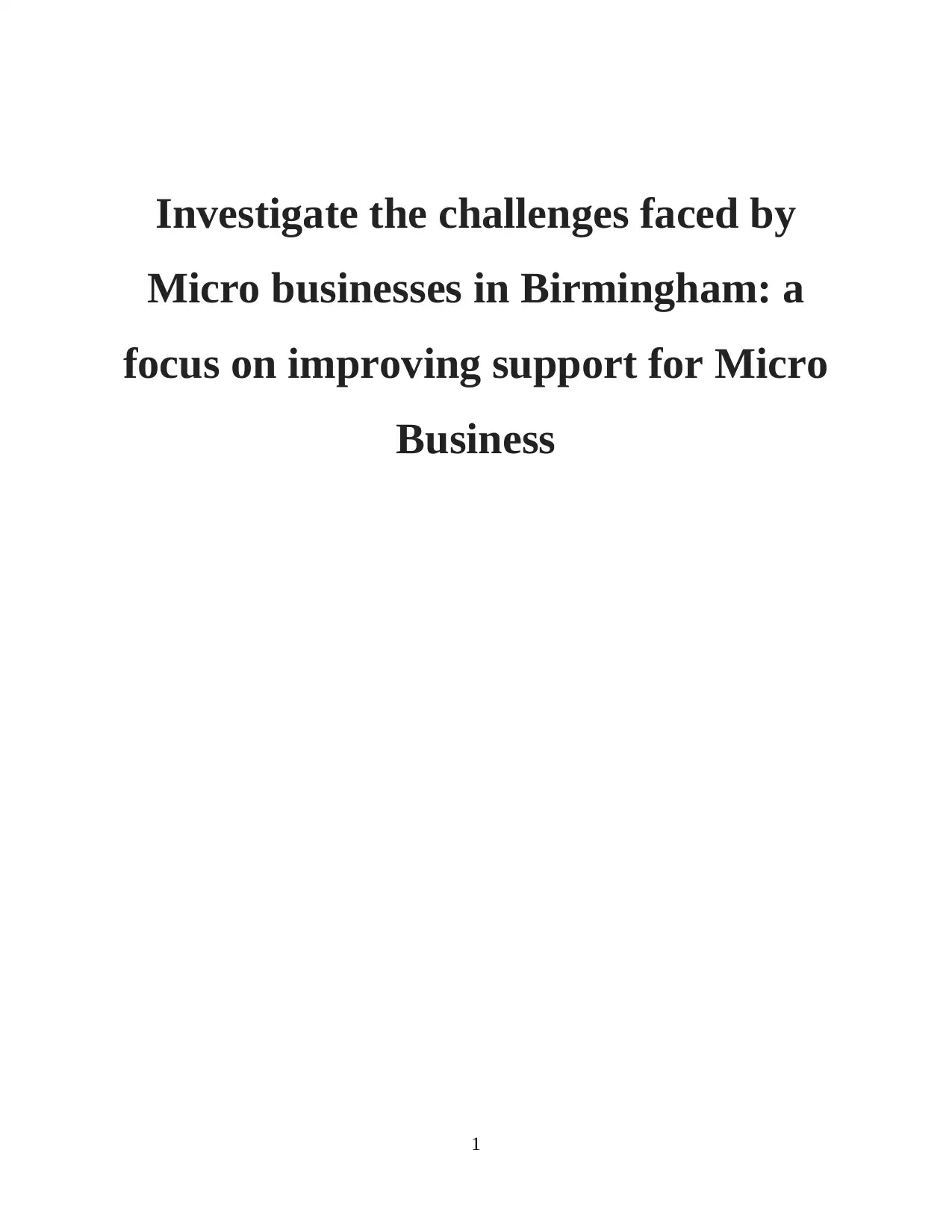
Investigate the challenges faced by
Micro businesses in Birmingham: a
focus on improving support for Micro
Business
1
Micro businesses in Birmingham: a
focus on improving support for Micro
Business
1
Paraphrase This Document
Need a fresh take? Get an instant paraphrase of this document with our AI Paraphraser
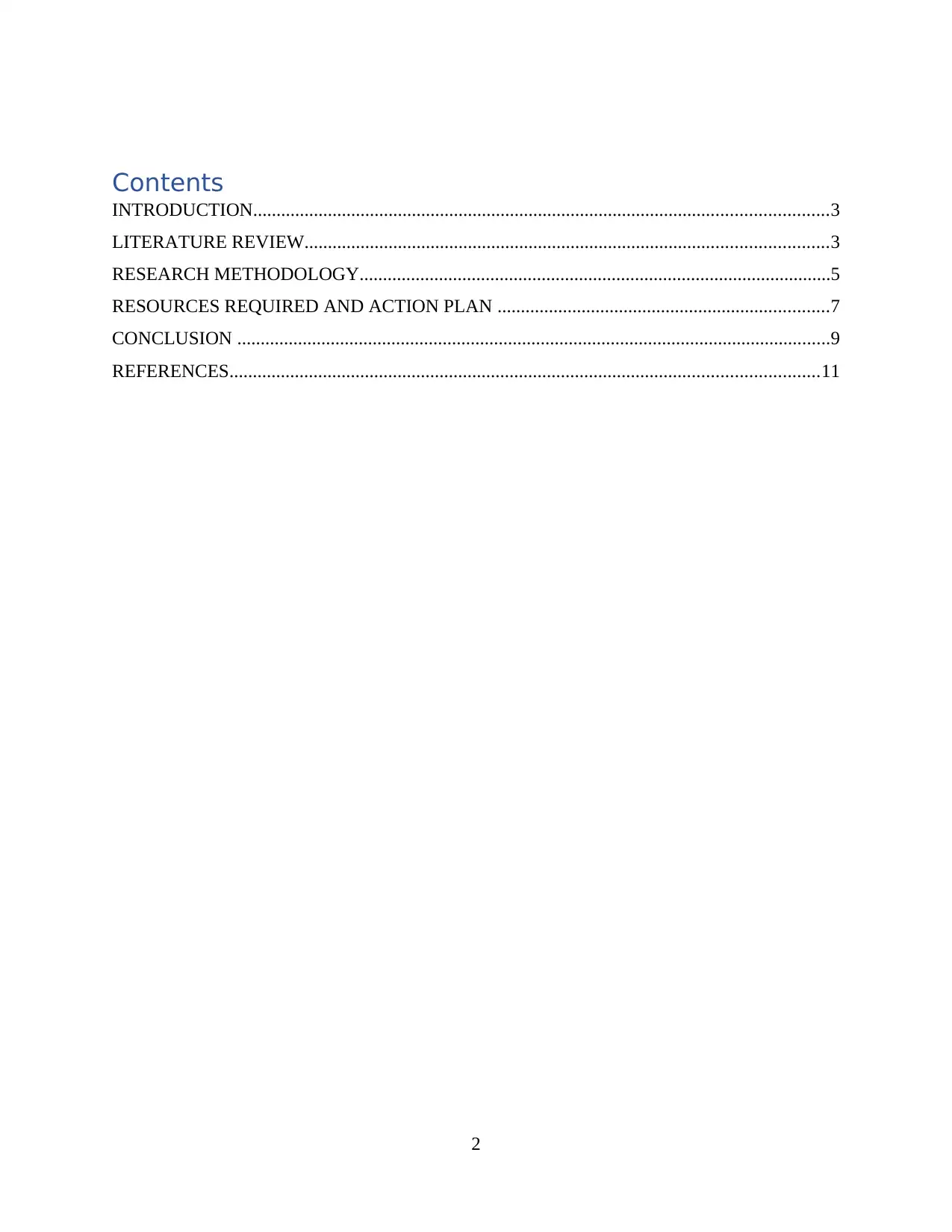
Contents
INTRODUCTION...........................................................................................................................3
LITERATURE REVIEW................................................................................................................3
RESEARCH METHODOLOGY.....................................................................................................5
RESOURCES REQUIRED AND ACTION PLAN .......................................................................7
CONCLUSION ...............................................................................................................................9
REFERENCES..............................................................................................................................11
2
INTRODUCTION...........................................................................................................................3
LITERATURE REVIEW................................................................................................................3
RESEARCH METHODOLOGY.....................................................................................................5
RESOURCES REQUIRED AND ACTION PLAN .......................................................................7
CONCLUSION ...............................................................................................................................9
REFERENCES..............................................................................................................................11
2
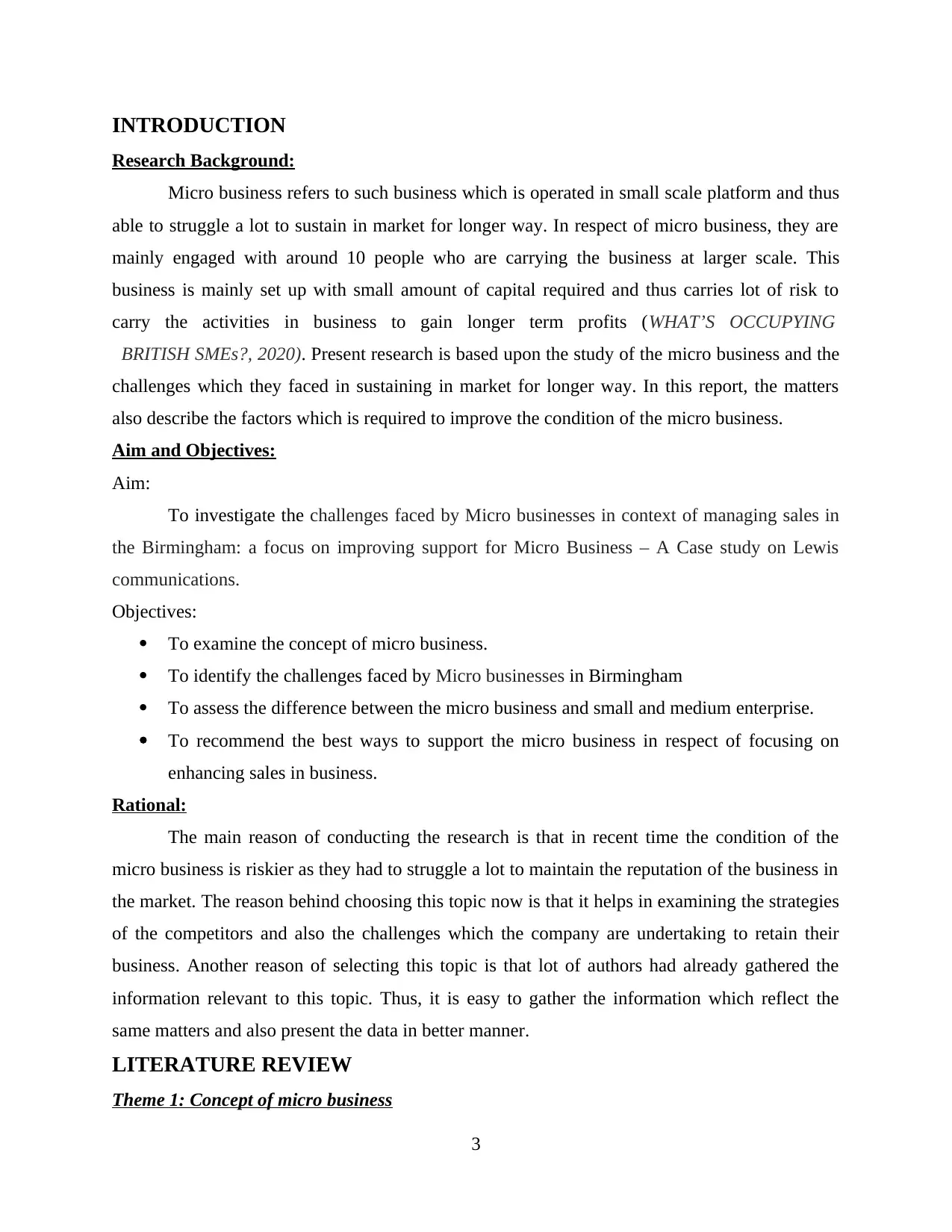
INTRODUCTION
Research Background:
Micro business refers to such business which is operated in small scale platform and thus
able to struggle a lot to sustain in market for longer way. In respect of micro business, they are
mainly engaged with around 10 people who are carrying the business at larger scale. This
business is mainly set up with small amount of capital required and thus carries lot of risk to
carry the activities in business to gain longer term profits (WHAT’S OCCUPYING
BRITISH SMEs?, 2020). Present research is based upon the study of the micro business and the
challenges which they faced in sustaining in market for longer way. In this report, the matters
also describe the factors which is required to improve the condition of the micro business.
Aim and Objectives:
Aim:
To investigate the challenges faced by Micro businesses in context of managing sales in
the Birmingham: a focus on improving support for Micro Business – A Case study on Lewis
communications.
Objectives:
To examine the concept of micro business.
To identify the challenges faced by Micro businesses in Birmingham
To assess the difference between the micro business and small and medium enterprise.
To recommend the best ways to support the micro business in respect of focusing on
enhancing sales in business.
Rational:
The main reason of conducting the research is that in recent time the condition of the
micro business is riskier as they had to struggle a lot to maintain the reputation of the business in
the market. The reason behind choosing this topic now is that it helps in examining the strategies
of the competitors and also the challenges which the company are undertaking to retain their
business. Another reason of selecting this topic is that lot of authors had already gathered the
information relevant to this topic. Thus, it is easy to gather the information which reflect the
same matters and also present the data in better manner.
LITERATURE REVIEW
Theme 1: Concept of micro business
3
Research Background:
Micro business refers to such business which is operated in small scale platform and thus
able to struggle a lot to sustain in market for longer way. In respect of micro business, they are
mainly engaged with around 10 people who are carrying the business at larger scale. This
business is mainly set up with small amount of capital required and thus carries lot of risk to
carry the activities in business to gain longer term profits (WHAT’S OCCUPYING
BRITISH SMEs?, 2020). Present research is based upon the study of the micro business and the
challenges which they faced in sustaining in market for longer way. In this report, the matters
also describe the factors which is required to improve the condition of the micro business.
Aim and Objectives:
Aim:
To investigate the challenges faced by Micro businesses in context of managing sales in
the Birmingham: a focus on improving support for Micro Business – A Case study on Lewis
communications.
Objectives:
To examine the concept of micro business.
To identify the challenges faced by Micro businesses in Birmingham
To assess the difference between the micro business and small and medium enterprise.
To recommend the best ways to support the micro business in respect of focusing on
enhancing sales in business.
Rational:
The main reason of conducting the research is that in recent time the condition of the
micro business is riskier as they had to struggle a lot to maintain the reputation of the business in
the market. The reason behind choosing this topic now is that it helps in examining the strategies
of the competitors and also the challenges which the company are undertaking to retain their
business. Another reason of selecting this topic is that lot of authors had already gathered the
information relevant to this topic. Thus, it is easy to gather the information which reflect the
same matters and also present the data in better manner.
LITERATURE REVIEW
Theme 1: Concept of micro business
3
⊘ This is a preview!⊘
Do you want full access?
Subscribe today to unlock all pages.

Trusted by 1+ million students worldwide
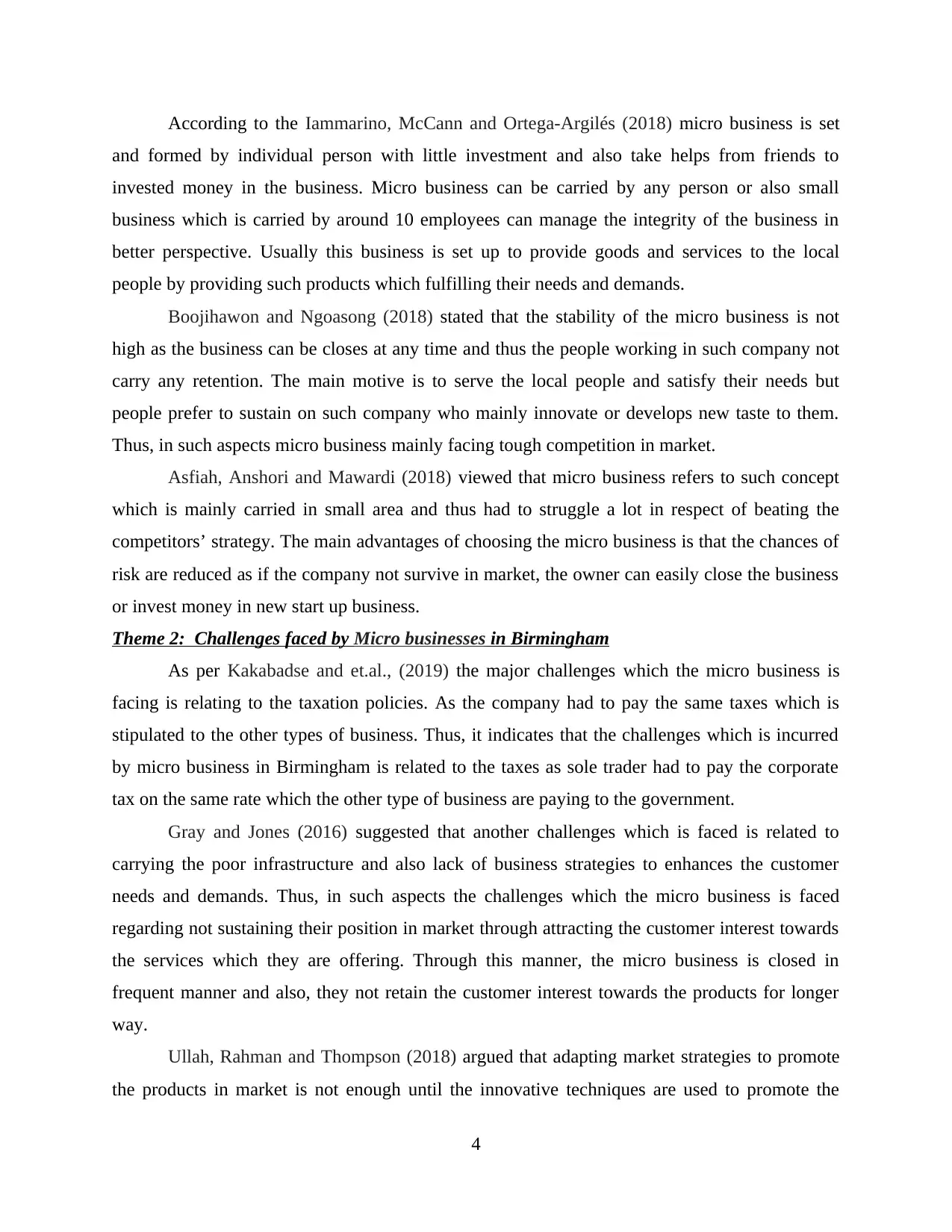
According to the Iammarino, McCann and Ortega-Argilés (2018) micro business is set
and formed by individual person with little investment and also take helps from friends to
invested money in the business. Micro business can be carried by any person or also small
business which is carried by around 10 employees can manage the integrity of the business in
better perspective. Usually this business is set up to provide goods and services to the local
people by providing such products which fulfilling their needs and demands.
Boojihawon and Ngoasong (2018) stated that the stability of the micro business is not
high as the business can be closes at any time and thus the people working in such company not
carry any retention. The main motive is to serve the local people and satisfy their needs but
people prefer to sustain on such company who mainly innovate or develops new taste to them.
Thus, in such aspects micro business mainly facing tough competition in market.
Asfiah, Anshori and Mawardi (2018) viewed that micro business refers to such concept
which is mainly carried in small area and thus had to struggle a lot in respect of beating the
competitors’ strategy. The main advantages of choosing the micro business is that the chances of
risk are reduced as if the company not survive in market, the owner can easily close the business
or invest money in new start up business.
Theme 2: Challenges faced by Micro businesses in Birmingham
As per Kakabadse and et.al., (2019) the major challenges which the micro business is
facing is relating to the taxation policies. As the company had to pay the same taxes which is
stipulated to the other types of business. Thus, it indicates that the challenges which is incurred
by micro business in Birmingham is related to the taxes as sole trader had to pay the corporate
tax on the same rate which the other type of business are paying to the government.
Gray and Jones (2016) suggested that another challenges which is faced is related to
carrying the poor infrastructure and also lack of business strategies to enhances the customer
needs and demands. Thus, in such aspects the challenges which the micro business is faced
regarding not sustaining their position in market through attracting the customer interest towards
the services which they are offering. Through this manner, the micro business is closed in
frequent manner and also, they not retain the customer interest towards the products for longer
way.
Ullah, Rahman and Thompson (2018) argued that adapting market strategies to promote
the products in market is not enough until the innovative techniques are used to promote the
4
and formed by individual person with little investment and also take helps from friends to
invested money in the business. Micro business can be carried by any person or also small
business which is carried by around 10 employees can manage the integrity of the business in
better perspective. Usually this business is set up to provide goods and services to the local
people by providing such products which fulfilling their needs and demands.
Boojihawon and Ngoasong (2018) stated that the stability of the micro business is not
high as the business can be closes at any time and thus the people working in such company not
carry any retention. The main motive is to serve the local people and satisfy their needs but
people prefer to sustain on such company who mainly innovate or develops new taste to them.
Thus, in such aspects micro business mainly facing tough competition in market.
Asfiah, Anshori and Mawardi (2018) viewed that micro business refers to such concept
which is mainly carried in small area and thus had to struggle a lot in respect of beating the
competitors’ strategy. The main advantages of choosing the micro business is that the chances of
risk are reduced as if the company not survive in market, the owner can easily close the business
or invest money in new start up business.
Theme 2: Challenges faced by Micro businesses in Birmingham
As per Kakabadse and et.al., (2019) the major challenges which the micro business is
facing is relating to the taxation policies. As the company had to pay the same taxes which is
stipulated to the other types of business. Thus, it indicates that the challenges which is incurred
by micro business in Birmingham is related to the taxes as sole trader had to pay the corporate
tax on the same rate which the other type of business are paying to the government.
Gray and Jones (2016) suggested that another challenges which is faced is related to
carrying the poor infrastructure and also lack of business strategies to enhances the customer
needs and demands. Thus, in such aspects the challenges which the micro business is faced
regarding not sustaining their position in market through attracting the customer interest towards
the services which they are offering. Through this manner, the micro business is closed in
frequent manner and also, they not retain the customer interest towards the products for longer
way.
Ullah, Rahman and Thompson (2018) argued that adapting market strategies to promote
the products in market is not enough until the innovative techniques are used to promote the
4
Paraphrase This Document
Need a fresh take? Get an instant paraphrase of this document with our AI Paraphraser
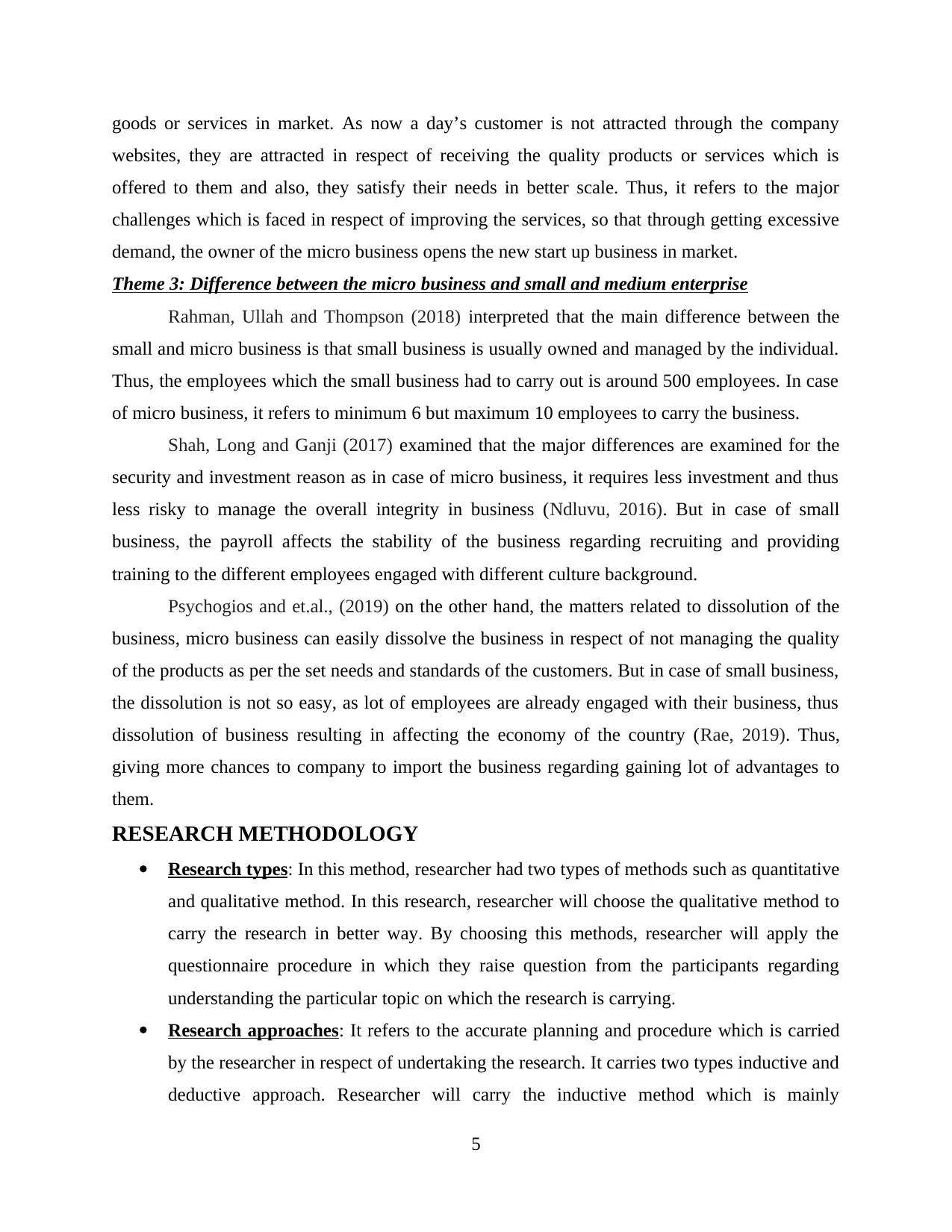
goods or services in market. As now a day’s customer is not attracted through the company
websites, they are attracted in respect of receiving the quality products or services which is
offered to them and also, they satisfy their needs in better scale. Thus, it refers to the major
challenges which is faced in respect of improving the services, so that through getting excessive
demand, the owner of the micro business opens the new start up business in market.
Theme 3: Difference between the micro business and small and medium enterprise
Rahman, Ullah and Thompson (2018) interpreted that the main difference between the
small and micro business is that small business is usually owned and managed by the individual.
Thus, the employees which the small business had to carry out is around 500 employees. In case
of micro business, it refers to minimum 6 but maximum 10 employees to carry the business.
Shah, Long and Ganji (2017) examined that the major differences are examined for the
security and investment reason as in case of micro business, it requires less investment and thus
less risky to manage the overall integrity in business (Ndluvu, 2016). But in case of small
business, the payroll affects the stability of the business regarding recruiting and providing
training to the different employees engaged with different culture background.
Psychogios and et.al., (2019) on the other hand, the matters related to dissolution of the
business, micro business can easily dissolve the business in respect of not managing the quality
of the products as per the set needs and standards of the customers. But in case of small business,
the dissolution is not so easy, as lot of employees are already engaged with their business, thus
dissolution of business resulting in affecting the economy of the country (Rae, 2019). Thus,
giving more chances to company to import the business regarding gaining lot of advantages to
them.
RESEARCH METHODOLOGY
Research types: In this method, researcher had two types of methods such as quantitative
and qualitative method. In this research, researcher will choose the qualitative method to
carry the research in better way. By choosing this methods, researcher will apply the
questionnaire procedure in which they raise question from the participants regarding
understanding the particular topic on which the research is carrying.
Research approaches: It refers to the accurate planning and procedure which is carried
by the researcher in respect of undertaking the research. It carries two types inductive and
deductive approach. Researcher will carry the inductive method which is mainly
5
websites, they are attracted in respect of receiving the quality products or services which is
offered to them and also, they satisfy their needs in better scale. Thus, it refers to the major
challenges which is faced in respect of improving the services, so that through getting excessive
demand, the owner of the micro business opens the new start up business in market.
Theme 3: Difference between the micro business and small and medium enterprise
Rahman, Ullah and Thompson (2018) interpreted that the main difference between the
small and micro business is that small business is usually owned and managed by the individual.
Thus, the employees which the small business had to carry out is around 500 employees. In case
of micro business, it refers to minimum 6 but maximum 10 employees to carry the business.
Shah, Long and Ganji (2017) examined that the major differences are examined for the
security and investment reason as in case of micro business, it requires less investment and thus
less risky to manage the overall integrity in business (Ndluvu, 2016). But in case of small
business, the payroll affects the stability of the business regarding recruiting and providing
training to the different employees engaged with different culture background.
Psychogios and et.al., (2019) on the other hand, the matters related to dissolution of the
business, micro business can easily dissolve the business in respect of not managing the quality
of the products as per the set needs and standards of the customers. But in case of small business,
the dissolution is not so easy, as lot of employees are already engaged with their business, thus
dissolution of business resulting in affecting the economy of the country (Rae, 2019). Thus,
giving more chances to company to import the business regarding gaining lot of advantages to
them.
RESEARCH METHODOLOGY
Research types: In this method, researcher had two types of methods such as quantitative
and qualitative method. In this research, researcher will choose the qualitative method to
carry the research in better way. By choosing this methods, researcher will apply the
questionnaire procedure in which they raise question from the participants regarding
understanding the particular topic on which the research is carrying.
Research approaches: It refers to the accurate planning and procedure which is carried
by the researcher in respect of undertaking the research. It carries two types inductive and
deductive approach. Researcher will carry the inductive method which is mainly
5
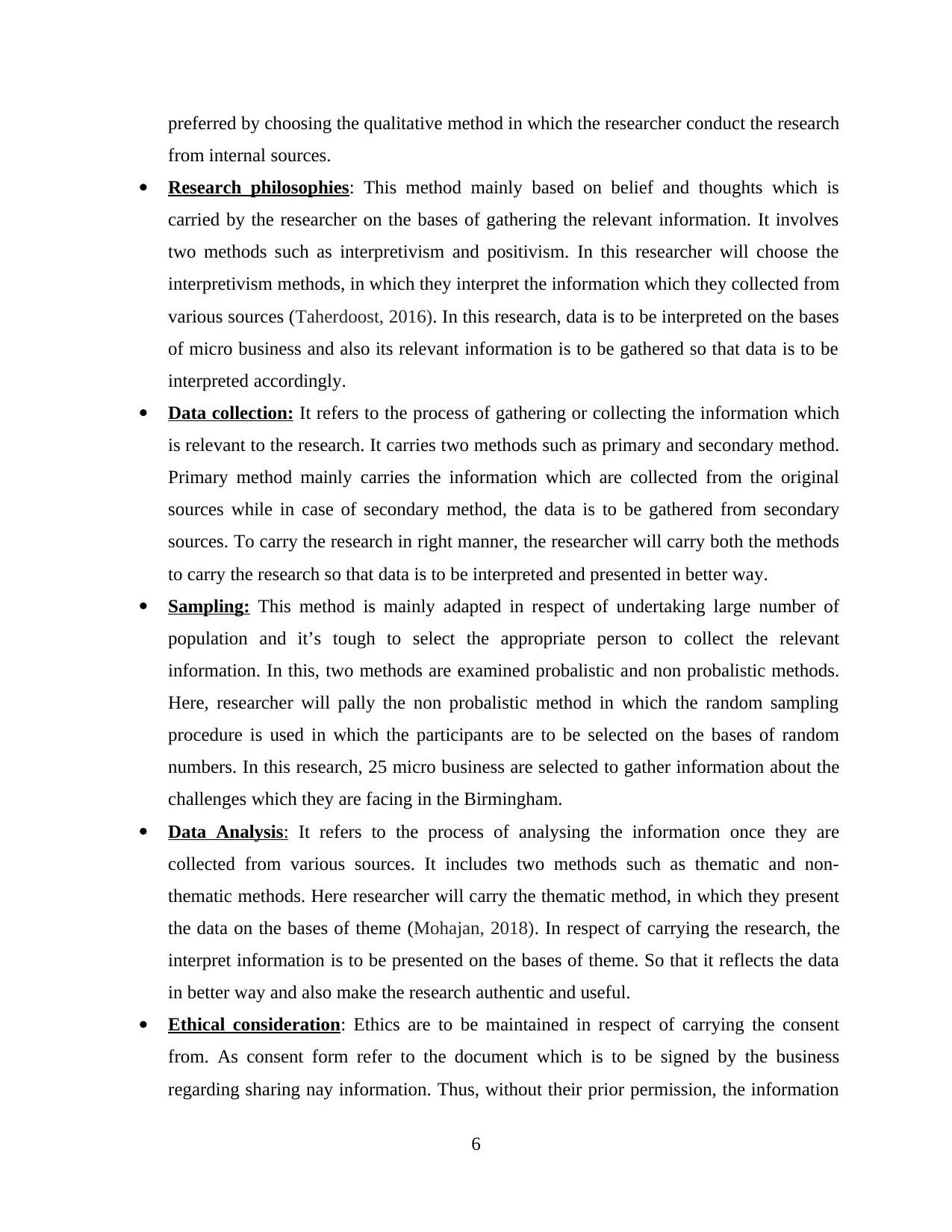
preferred by choosing the qualitative method in which the researcher conduct the research
from internal sources.
Research philosophies: This method mainly based on belief and thoughts which is
carried by the researcher on the bases of gathering the relevant information. It involves
two methods such as interpretivism and positivism. In this researcher will choose the
interpretivism methods, in which they interpret the information which they collected from
various sources (Taherdoost, 2016). In this research, data is to be interpreted on the bases
of micro business and also its relevant information is to be gathered so that data is to be
interpreted accordingly.
Data collection: It refers to the process of gathering or collecting the information which
is relevant to the research. It carries two methods such as primary and secondary method.
Primary method mainly carries the information which are collected from the original
sources while in case of secondary method, the data is to be gathered from secondary
sources. To carry the research in right manner, the researcher will carry both the methods
to carry the research so that data is to be interpreted and presented in better way.
Sampling: This method is mainly adapted in respect of undertaking large number of
population and it’s tough to select the appropriate person to collect the relevant
information. In this, two methods are examined probalistic and non probalistic methods.
Here, researcher will pally the non probalistic method in which the random sampling
procedure is used in which the participants are to be selected on the bases of random
numbers. In this research, 25 micro business are selected to gather information about the
challenges which they are facing in the Birmingham.
Data Analysis: It refers to the process of analysing the information once they are
collected from various sources. It includes two methods such as thematic and non-
thematic methods. Here researcher will carry the thematic method, in which they present
the data on the bases of theme (Mohajan, 2018). In respect of carrying the research, the
interpret information is to be presented on the bases of theme. So that it reflects the data
in better way and also make the research authentic and useful.
Ethical consideration: Ethics are to be maintained in respect of carrying the consent
from. As consent form refer to the document which is to be signed by the business
regarding sharing nay information. Thus, without their prior permission, the information
6
from internal sources.
Research philosophies: This method mainly based on belief and thoughts which is
carried by the researcher on the bases of gathering the relevant information. It involves
two methods such as interpretivism and positivism. In this researcher will choose the
interpretivism methods, in which they interpret the information which they collected from
various sources (Taherdoost, 2016). In this research, data is to be interpreted on the bases
of micro business and also its relevant information is to be gathered so that data is to be
interpreted accordingly.
Data collection: It refers to the process of gathering or collecting the information which
is relevant to the research. It carries two methods such as primary and secondary method.
Primary method mainly carries the information which are collected from the original
sources while in case of secondary method, the data is to be gathered from secondary
sources. To carry the research in right manner, the researcher will carry both the methods
to carry the research so that data is to be interpreted and presented in better way.
Sampling: This method is mainly adapted in respect of undertaking large number of
population and it’s tough to select the appropriate person to collect the relevant
information. In this, two methods are examined probalistic and non probalistic methods.
Here, researcher will pally the non probalistic method in which the random sampling
procedure is used in which the participants are to be selected on the bases of random
numbers. In this research, 25 micro business are selected to gather information about the
challenges which they are facing in the Birmingham.
Data Analysis: It refers to the process of analysing the information once they are
collected from various sources. It includes two methods such as thematic and non-
thematic methods. Here researcher will carry the thematic method, in which they present
the data on the bases of theme (Mohajan, 2018). In respect of carrying the research, the
interpret information is to be presented on the bases of theme. So that it reflects the data
in better way and also make the research authentic and useful.
Ethical consideration: Ethics are to be maintained in respect of carrying the consent
from. As consent form refer to the document which is to be signed by the business
regarding sharing nay information. Thus, without their prior permission, the information
6
⊘ This is a preview!⊘
Do you want full access?
Subscribe today to unlock all pages.

Trusted by 1+ million students worldwide
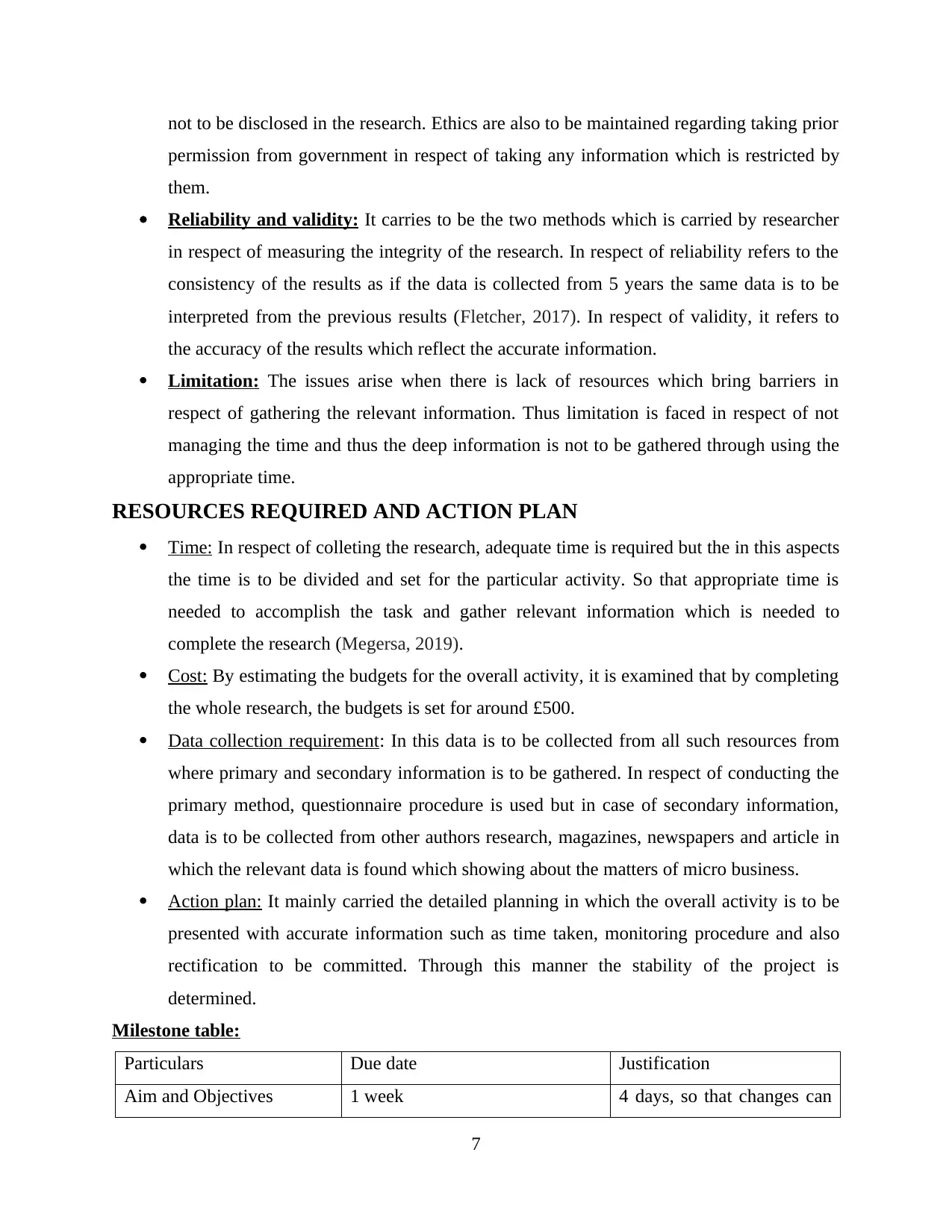
not to be disclosed in the research. Ethics are also to be maintained regarding taking prior
permission from government in respect of taking any information which is restricted by
them.
Reliability and validity: It carries to be the two methods which is carried by researcher
in respect of measuring the integrity of the research. In respect of reliability refers to the
consistency of the results as if the data is collected from 5 years the same data is to be
interpreted from the previous results (Fletcher, 2017). In respect of validity, it refers to
the accuracy of the results which reflect the accurate information.
Limitation: The issues arise when there is lack of resources which bring barriers in
respect of gathering the relevant information. Thus limitation is faced in respect of not
managing the time and thus the deep information is not to be gathered through using the
appropriate time.
RESOURCES REQUIRED AND ACTION PLAN
Time: In respect of colleting the research, adequate time is required but the in this aspects
the time is to be divided and set for the particular activity. So that appropriate time is
needed to accomplish the task and gather relevant information which is needed to
complete the research (Megersa, 2019).
Cost: By estimating the budgets for the overall activity, it is examined that by completing
the whole research, the budgets is set for around £500.
Data collection requirement: In this data is to be collected from all such resources from
where primary and secondary information is to be gathered. In respect of conducting the
primary method, questionnaire procedure is used but in case of secondary information,
data is to be collected from other authors research, magazines, newspapers and article in
which the relevant data is found which showing about the matters of micro business.
Action plan: It mainly carried the detailed planning in which the overall activity is to be
presented with accurate information such as time taken, monitoring procedure and also
rectification to be committed. Through this manner the stability of the project is
determined.
Milestone table:
Particulars Due date Justification
Aim and Objectives 1 week 4 days, so that changes can
7
permission from government in respect of taking any information which is restricted by
them.
Reliability and validity: It carries to be the two methods which is carried by researcher
in respect of measuring the integrity of the research. In respect of reliability refers to the
consistency of the results as if the data is collected from 5 years the same data is to be
interpreted from the previous results (Fletcher, 2017). In respect of validity, it refers to
the accuracy of the results which reflect the accurate information.
Limitation: The issues arise when there is lack of resources which bring barriers in
respect of gathering the relevant information. Thus limitation is faced in respect of not
managing the time and thus the deep information is not to be gathered through using the
appropriate time.
RESOURCES REQUIRED AND ACTION PLAN
Time: In respect of colleting the research, adequate time is required but the in this aspects
the time is to be divided and set for the particular activity. So that appropriate time is
needed to accomplish the task and gather relevant information which is needed to
complete the research (Megersa, 2019).
Cost: By estimating the budgets for the overall activity, it is examined that by completing
the whole research, the budgets is set for around £500.
Data collection requirement: In this data is to be collected from all such resources from
where primary and secondary information is to be gathered. In respect of conducting the
primary method, questionnaire procedure is used but in case of secondary information,
data is to be collected from other authors research, magazines, newspapers and article in
which the relevant data is found which showing about the matters of micro business.
Action plan: It mainly carried the detailed planning in which the overall activity is to be
presented with accurate information such as time taken, monitoring procedure and also
rectification to be committed. Through this manner the stability of the project is
determined.
Milestone table:
Particulars Due date Justification
Aim and Objectives 1 week 4 days, so that changes can
7
Paraphrase This Document
Need a fresh take? Get an instant paraphrase of this document with our AI Paraphraser
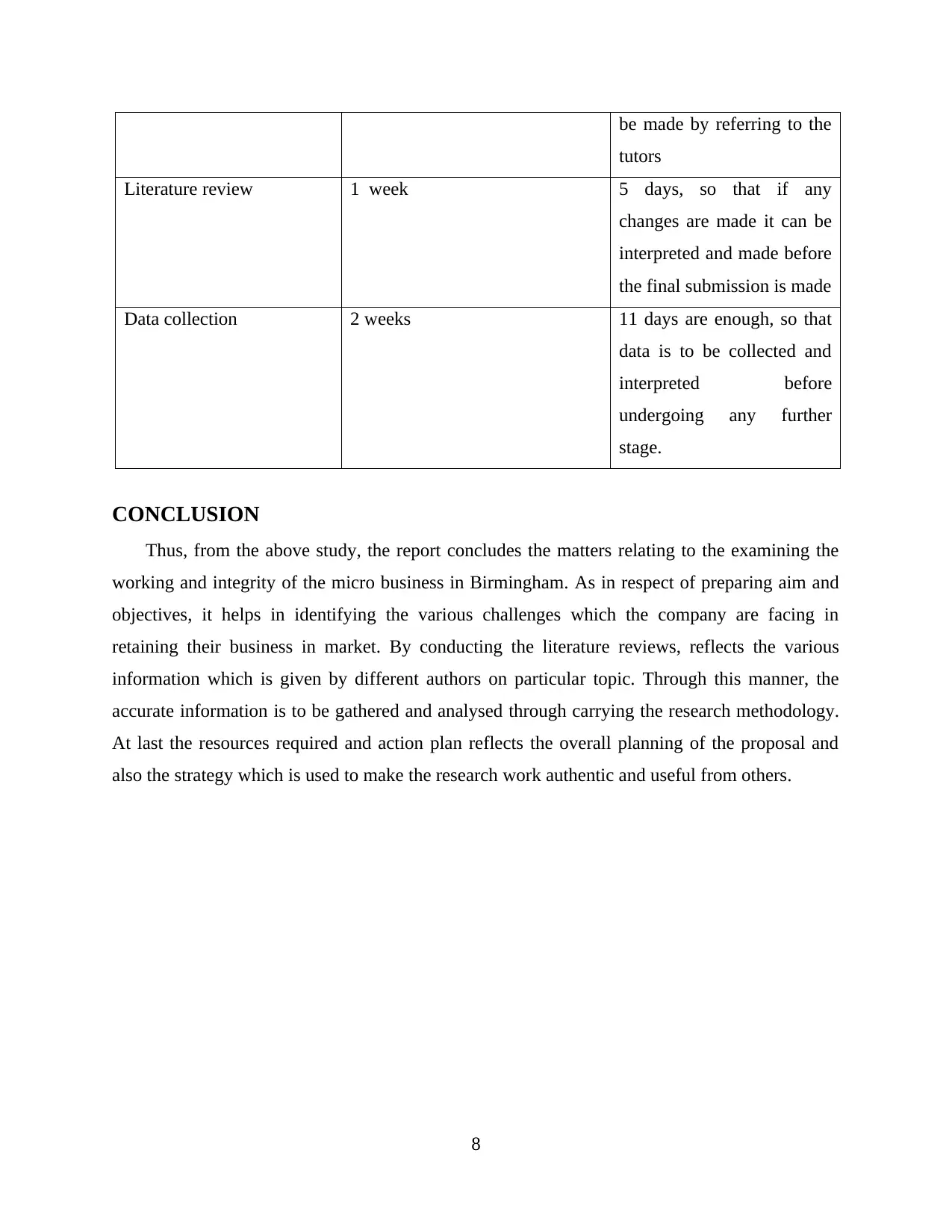
be made by referring to the
tutors
Literature review 1 week 5 days, so that if any
changes are made it can be
interpreted and made before
the final submission is made
Data collection 2 weeks 11 days are enough, so that
data is to be collected and
interpreted before
undergoing any further
stage.
CONCLUSION
Thus, from the above study, the report concludes the matters relating to the examining the
working and integrity of the micro business in Birmingham. As in respect of preparing aim and
objectives, it helps in identifying the various challenges which the company are facing in
retaining their business in market. By conducting the literature reviews, reflects the various
information which is given by different authors on particular topic. Through this manner, the
accurate information is to be gathered and analysed through carrying the research methodology.
At last the resources required and action plan reflects the overall planning of the proposal and
also the strategy which is used to make the research work authentic and useful from others.
8
tutors
Literature review 1 week 5 days, so that if any
changes are made it can be
interpreted and made before
the final submission is made
Data collection 2 weeks 11 days are enough, so that
data is to be collected and
interpreted before
undergoing any further
stage.
CONCLUSION
Thus, from the above study, the report concludes the matters relating to the examining the
working and integrity of the micro business in Birmingham. As in respect of preparing aim and
objectives, it helps in identifying the various challenges which the company are facing in
retaining their business in market. By conducting the literature reviews, reflects the various
information which is given by different authors on particular topic. Through this manner, the
accurate information is to be gathered and analysed through carrying the research methodology.
At last the resources required and action plan reflects the overall planning of the proposal and
also the strategy which is used to make the research work authentic and useful from others.
8
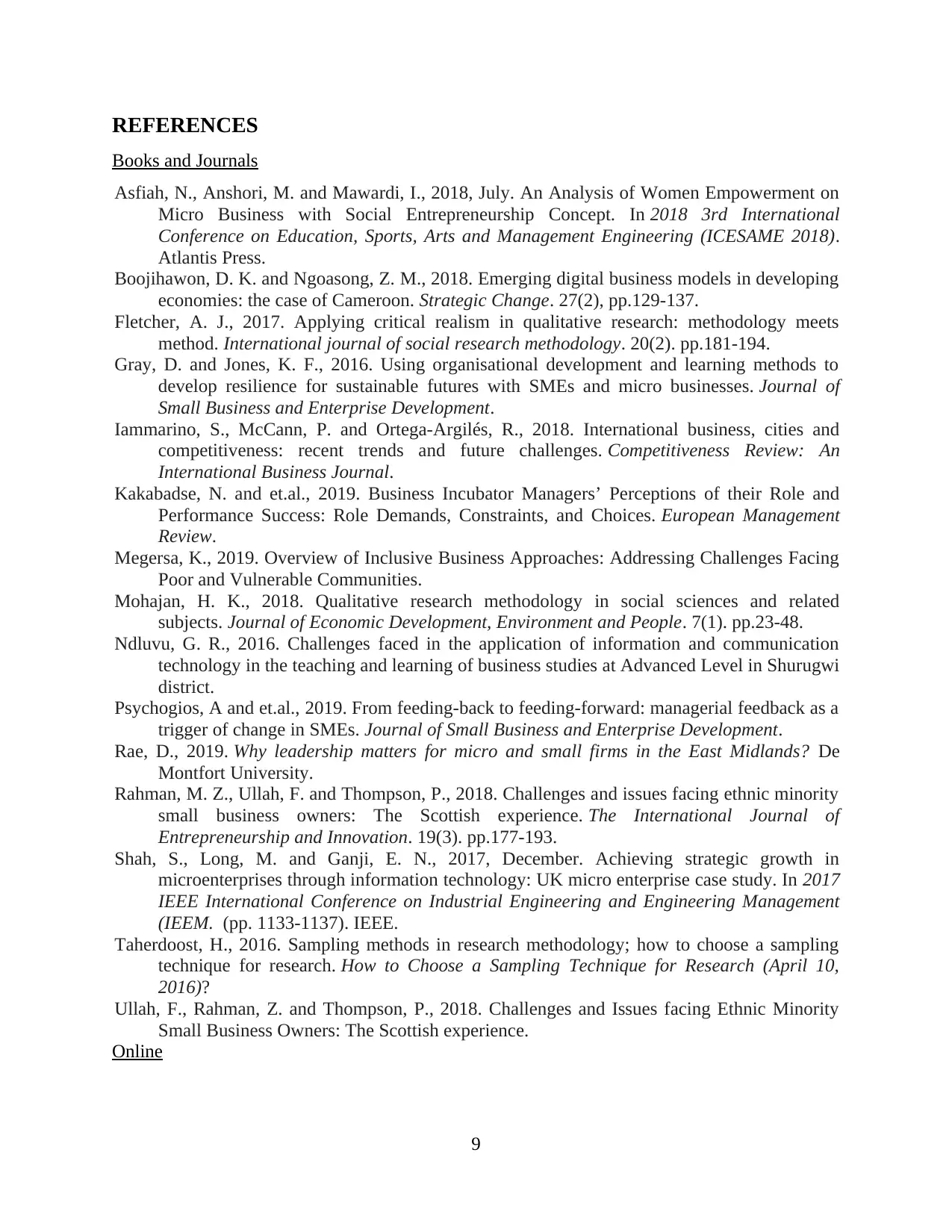
REFERENCES
Books and Journals
Asfiah, N., Anshori, M. and Mawardi, I., 2018, July. An Analysis of Women Empowerment on
Micro Business with Social Entrepreneurship Concept. In 2018 3rd International
Conference on Education, Sports, Arts and Management Engineering (ICESAME 2018).
Atlantis Press.
Boojihawon, D. K. and Ngoasong, Z. M., 2018. Emerging digital business models in developing
economies: the case of Cameroon. Strategic Change. 27(2), pp.129-137.
Fletcher, A. J., 2017. Applying critical realism in qualitative research: methodology meets
method. International journal of social research methodology. 20(2). pp.181-194.
Gray, D. and Jones, K. F., 2016. Using organisational development and learning methods to
develop resilience for sustainable futures with SMEs and micro businesses. Journal of
Small Business and Enterprise Development.
Iammarino, S., McCann, P. and Ortega-Argilés, R., 2018. International business, cities and
competitiveness: recent trends and future challenges. Competitiveness Review: An
International Business Journal.
Kakabadse, N. and et.al., 2019. Business Incubator Managers’ Perceptions of their Role and
Performance Success: Role Demands, Constraints, and Choices. European Management
Review.
Megersa, K., 2019. Overview of Inclusive Business Approaches: Addressing Challenges Facing
Poor and Vulnerable Communities.
Mohajan, H. K., 2018. Qualitative research methodology in social sciences and related
subjects. Journal of Economic Development, Environment and People. 7(1). pp.23-48.
Ndluvu, G. R., 2016. Challenges faced in the application of information and communication
technology in the teaching and learning of business studies at Advanced Level in Shurugwi
district.
Psychogios, A and et.al., 2019. From feeding-back to feeding-forward: managerial feedback as a
trigger of change in SMEs. Journal of Small Business and Enterprise Development.
Rae, D., 2019. Why leadership matters for micro and small firms in the East Midlands? De
Montfort University.
Rahman, M. Z., Ullah, F. and Thompson, P., 2018. Challenges and issues facing ethnic minority
small business owners: The Scottish experience. The International Journal of
Entrepreneurship and Innovation. 19(3). pp.177-193.
Shah, S., Long, M. and Ganji, E. N., 2017, December. Achieving strategic growth in
microenterprises through information technology: UK micro enterprise case study. In 2017
IEEE International Conference on Industrial Engineering and Engineering Management
(IEEM. (pp. 1133-1137). IEEE.
Taherdoost, H., 2016. Sampling methods in research methodology; how to choose a sampling
technique for research. How to Choose a Sampling Technique for Research (April 10,
2016)?
Ullah, F., Rahman, Z. and Thompson, P., 2018. Challenges and Issues facing Ethnic Minority
Small Business Owners: The Scottish experience.
Online
9
Books and Journals
Asfiah, N., Anshori, M. and Mawardi, I., 2018, July. An Analysis of Women Empowerment on
Micro Business with Social Entrepreneurship Concept. In 2018 3rd International
Conference on Education, Sports, Arts and Management Engineering (ICESAME 2018).
Atlantis Press.
Boojihawon, D. K. and Ngoasong, Z. M., 2018. Emerging digital business models in developing
economies: the case of Cameroon. Strategic Change. 27(2), pp.129-137.
Fletcher, A. J., 2017. Applying critical realism in qualitative research: methodology meets
method. International journal of social research methodology. 20(2). pp.181-194.
Gray, D. and Jones, K. F., 2016. Using organisational development and learning methods to
develop resilience for sustainable futures with SMEs and micro businesses. Journal of
Small Business and Enterprise Development.
Iammarino, S., McCann, P. and Ortega-Argilés, R., 2018. International business, cities and
competitiveness: recent trends and future challenges. Competitiveness Review: An
International Business Journal.
Kakabadse, N. and et.al., 2019. Business Incubator Managers’ Perceptions of their Role and
Performance Success: Role Demands, Constraints, and Choices. European Management
Review.
Megersa, K., 2019. Overview of Inclusive Business Approaches: Addressing Challenges Facing
Poor and Vulnerable Communities.
Mohajan, H. K., 2018. Qualitative research methodology in social sciences and related
subjects. Journal of Economic Development, Environment and People. 7(1). pp.23-48.
Ndluvu, G. R., 2016. Challenges faced in the application of information and communication
technology in the teaching and learning of business studies at Advanced Level in Shurugwi
district.
Psychogios, A and et.al., 2019. From feeding-back to feeding-forward: managerial feedback as a
trigger of change in SMEs. Journal of Small Business and Enterprise Development.
Rae, D., 2019. Why leadership matters for micro and small firms in the East Midlands? De
Montfort University.
Rahman, M. Z., Ullah, F. and Thompson, P., 2018. Challenges and issues facing ethnic minority
small business owners: The Scottish experience. The International Journal of
Entrepreneurship and Innovation. 19(3). pp.177-193.
Shah, S., Long, M. and Ganji, E. N., 2017, December. Achieving strategic growth in
microenterprises through information technology: UK micro enterprise case study. In 2017
IEEE International Conference on Industrial Engineering and Engineering Management
(IEEM. (pp. 1133-1137). IEEE.
Taherdoost, H., 2016. Sampling methods in research methodology; how to choose a sampling
technique for research. How to Choose a Sampling Technique for Research (April 10,
2016)?
Ullah, F., Rahman, Z. and Thompson, P., 2018. Challenges and Issues facing Ethnic Minority
Small Business Owners: The Scottish experience.
Online
9
⊘ This is a preview!⊘
Do you want full access?
Subscribe today to unlock all pages.

Trusted by 1+ million students worldwide
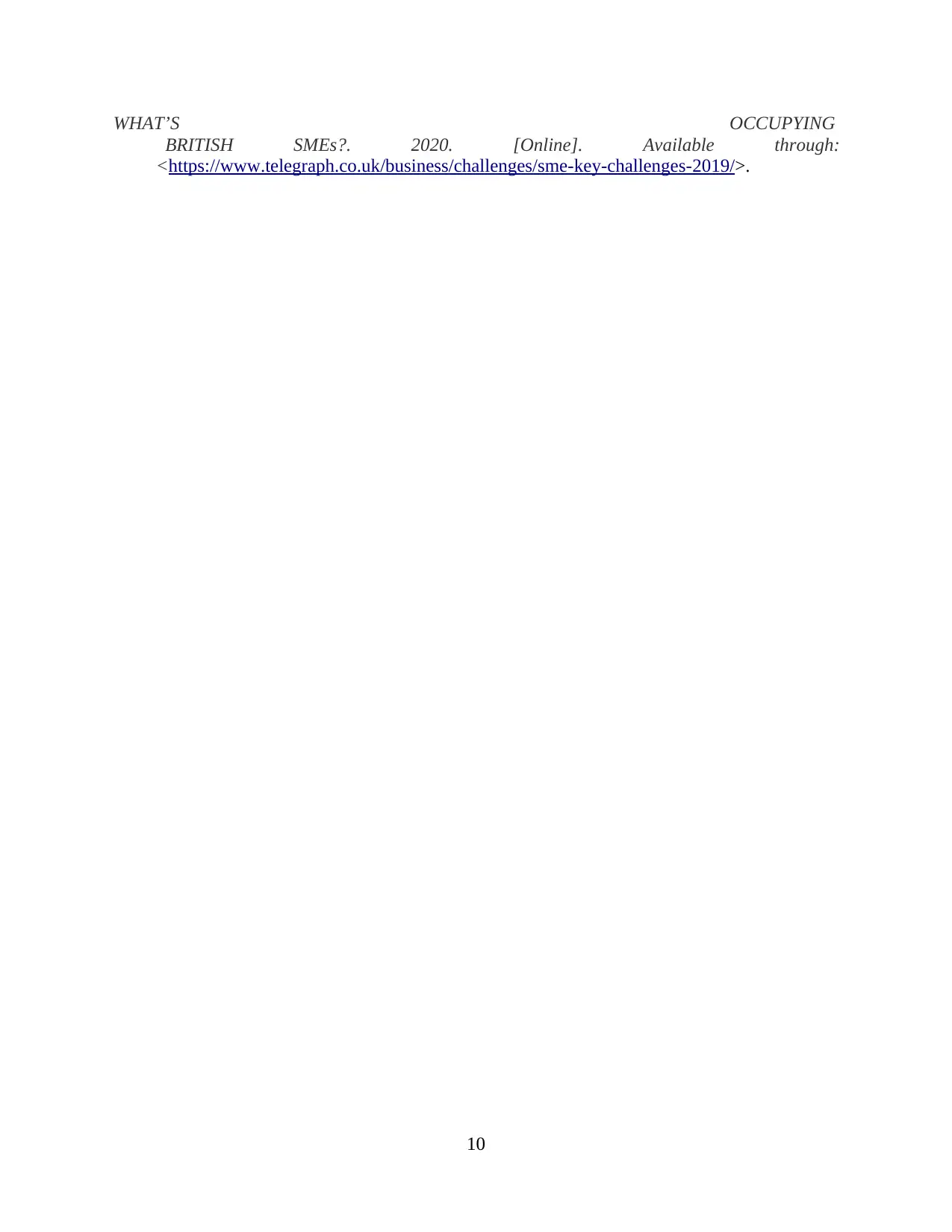
WHAT’S OCCUPYING
BRITISH SMEs?. 2020. [Online]. Available through:
<https://www.telegraph.co.uk/business/challenges/sme-key-challenges-2019/>.
10
BRITISH SMEs?. 2020. [Online]. Available through:
<https://www.telegraph.co.uk/business/challenges/sme-key-challenges-2019/>.
10
1 out of 10
Related Documents
Your All-in-One AI-Powered Toolkit for Academic Success.
+13062052269
info@desklib.com
Available 24*7 on WhatsApp / Email
![[object Object]](/_next/static/media/star-bottom.7253800d.svg)
Unlock your academic potential
Copyright © 2020–2025 A2Z Services. All Rights Reserved. Developed and managed by ZUCOL.





